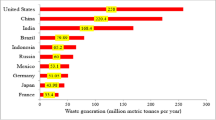Abstract
A lifetime of landfill with the waste composition and conditions specific to big and small towns of Ukraine is reproduced with landfill simulation reactors in 12-week period. The heavy metals concentrations (lead, nickel, chromium, cadmium) and physico-chemical parameters affecting (pH, reduction potential, conductivity, DOC, COD) are measured in the leachate formed during the reactors exploitation. The results show a quite high content of the heavy metals. Higher concentrations are found where more organic fraction is present in the waste. There are conditions inside the reactors, especially acidity, which are crucial at the early stages. Further, a significant impact can be caused by unequal distribution of heavy metals in the waste body. Also due to accelerated water regime in the reactors, the heavy metals concentrations in a landfill leachate are predicted up to 50–55 years. Forecast shows multiple (2–18 times) exceeding the allowable concentrations of all heavy metals.







Similar content being viewed by others
References
Bozkurt S, Moreno L, Neretnieks I (2000) Long-term processes in waste deposits. Sci Total Environ 250:101–121
Christensen T, Tjell J (1984) Leaching from land disposed municipal compost: 4. Heavy metals. Waste Manag Res 2:347–357
Ehrig HJ (1989) Leachate quality. In: Christensen T, Cossu R, Stegmann R (eds) Sanitary landfilling: process, technology and environment impact. Academic Press, London, pp 213–229
Qu X, He PJ, Shao LM, Lee DJ (2008) Heavy metals mobility in full-scale bioreactor landfill: initial stage. Chemosphere 70(5):769–777
Bozkurt S, Moreno L, Neretnieks I (1999) Long-term fate of organics in waste deposits and its effect on metal release. Sci Total Environ 228:135–152
Christensen JB, Christensen TH (1999) Complexation of Cd, Ni, and Zn by DOC in polluted groundwater: a comparison of approaches using resin exchange, aquifer material sorption, and computer speciation models (WHAM and MINTEQA2). Environ Sci Technol 33(21):3857–3863
Mor S, Ravindra K, Dahiya R, Chandra A (2006) Leachate characterization and assessment of groundwater pollution near municipal solid waste landfill site. Environ Monit Assess 118:435–456
Kjeldsen P, Barlaz MA, Rooker AP, Baun A, Ledin A, Christensen TH (2002) Present and long-term composition of MSW landfill leachate: a review. Crit Rev Environ Sci Technol 32(4):297–336
Andreas L (2000) Langzeitemissionsverhalten von Deponien für Siedlungsabfälle in den neuen Bundesländern. Dr.-Ing. thesis, Technical University of Dresden, Germany
Ehrig HJ, Höring K, Helfer A (1998) Mechanisch-biologische Behandlung von zu deponierenden Abfaellen. In: Teilvorhaben 3/4: Anforderungen an und Bewertung von biologischen Vorbehandlungen für die Ablagerung Abschlussbericht. Forschungsverbundvorhaben des Bundesministeriums für Bildung, Wissenschaft, Forschung und Technologie (Förderkennzeichen BMBF 1480964). Bergische Universität-Gesamthochschule Wuppertal, Germany
Heyer KU (2003) Emissionsreduzierung in der Deponienachsorge. Hamburger Berichte, Band 21. Verlag Abfall aktuell, Stuttgart
Nguyen XH (2011) A Laboratory Simulation of Municipal Solid Waste Biodegradation in Landfill Bioreactors. Dr.-Ing. thesis, Technical University of Dresden, Germany
Bauer MJ, Herrmann R (1997) Estimation of the environmental contamination by phthalic acid esters leaching from household wastes. Sci Total Environ 208(1–2):49–57
Belevi H, Baccini P (1989) Long-term behaviour of municipal solid waste landfills. Waste Manag Res 7:43–56
Janz A (2010) Schwermetalle aus Elektroaltgeräten und Batterien im kommunalen Restabfall. Potenziale, Mobilisierung und Freisetzung während der Deponierung. Dr.-Ing. thesis, Technical University of Dresden, Germany
Warith M (2002) Bioreactor landfills: experimental and field results. Waste Manag 22(1):7–17
Bilgili MS, Demir A, Ince M, Örkaya B (2007) Metal concentrations of simulated aerobic and anaerobic pilot scale landfill reactors. J Hazard Mater 145:186–194
Flyhammar P, Tamaddon F, Bengtsson L (1998) Heavy metals in a municipal solid waste deposition cell. Waste Manage Res 16(5):403–410
Gertziuk M, Kovalchuk T, Kapral K, Lysychenko G (2010) The analysis of the leachate of the landfill No. 5 of Kyiv (in Ukrainian). Technog Environ Saf Civ Prot 1:98–105
Haydin M, Diakiv V, Pohrebennyk V, Pashuk A (2013) The chemical composition of the leachate of landfill of Lviv (in Ukrainian). Nat West Polissya Neighb Ter 10:43–49
Ishchenko V (2017) Soil contamination by heavy metal mobile forms near landfill. Int J Environ Waste Manag 20(1):66–74
Sekman E, Top S, Varank G, Bilgili MS (2011) Pilot-scale investigation of aeration rate effect on leachate characteristics in landfills. Fresenius Environ Bull 20(7a):1841–1852
Erses AS, Onay TT (2003) In situ heavy metal attenuation in landfills under methanogenic conditions. J Hazard Mater 99(2):159–175
Ciavatta C, Govi M, Pasotti L, Sequi P (1993) Evaluation of heavy metals during stabilization of organic matter in compost produced with municipal solid wastes. Bioresour Technol 43:147–153
Flyhammar P, Håkansson K (1999) The release of heavy metals in stabilised MSW by oxidation. Sci Total Environ 243:291–303
Kim H, Jang YC, Townsend T (2011) The behavior and long-term fate of metals in simulated landfill bioreactors under aerobic and anaerobic conditions. J Hazard Mater 194:369–377
Altmann RS, Bourg AM (1997) Cadmium mobilisation under conditions simulating anaerobic to aerobic transition in a landfill leachate-polluted aquifer. Water Air Soil Pollut 94(3–4):385–392
Andreas L, Bilitewski B (1999) Effects of waste quality and landfill technology on the long-term behaviour of municipal landfills. Waste Manag Res 17:413–423
Ramke HG (1991) Hydraulische Beurteilung und Dimensionierung der Basisentwässerung von Deponien fester Siedlungsabfälle. Dr.-Ing. thesis, TU Braunschweig, Germany
Rules of wastewater acceptance to municipal sewage systems of Ukrainian municipalities (2002) Decree No. 37 of the State Committee for Construction, Architecture and Residential Policy of Ukraine, 19.02.2002, Kyiv, Ukraine
Fellner J, Döberl G, Allgaier G, Brunner PH (2009) Comparing field investigations with laboratory models to predict landfill leachate emissions. Waste Manag 29(6):1844–1851
Acknowledgements
The author would like to express the gratitude to collective of the Institute of Waste Management and Contaminated Sites Treatment (Technical University of Dresden) for technical assistance as well as to Ministry of Education and Science of Ukraine for financial support of this research.
Author information
Authors and Affiliations
Corresponding author
Rights and permissions
About this article
Cite this article
Ishchenko, V. Prediction of heavy metals concentration in the leachate: a case study of Ukrainian waste. J Mater Cycles Waste Manag 20, 1892–1900 (2018). https://doi.org/10.1007/s10163-018-0740-7
Received:
Accepted:
Published:
Issue Date:
DOI: https://doi.org/10.1007/s10163-018-0740-7




